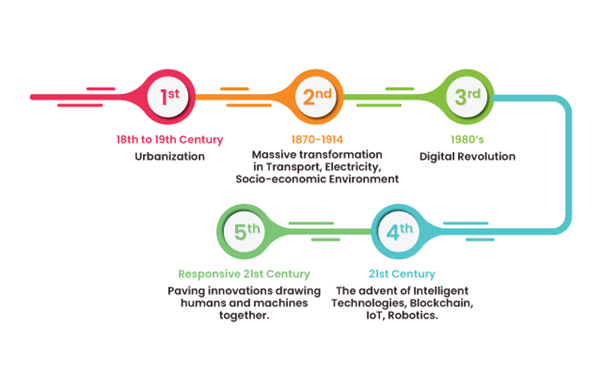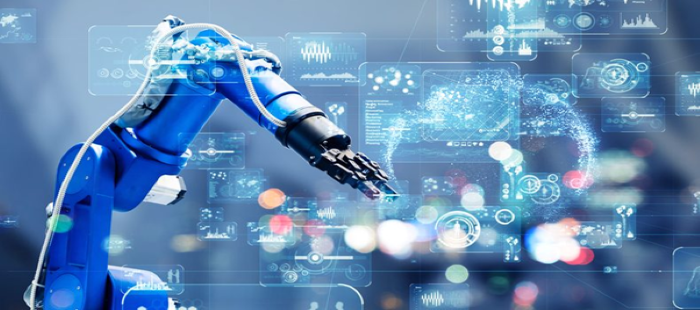
Although we may refer to an industrial revolution quite frequently, it’s still important to truly define what this term actually means and how it’s impacted our lives over the years:
The term “Industrial Revolution” was first coined to describe Britain’s economic and technological transformation from 1760 to 1840.
The more we read about the Fifth Industrial Revolution, the more we may be tempted to dismiss it as a slightly upgraded version of the Fourth Industrial Revolution.
However, in this piece, we’ll be exploring the idea of the industrial revolution and how this has gotten us to where we are today.
Background
We’ll start by defining exactly what an Industrial Revolution means.
An industrial revolution is made up of two components:
- New technologies – one of the most obvious is the invention of the steam engine that propelled manufacturing to new heights.
- Increasing production – each time a new technology is brought forth, manufacturing processes increase and improve exponentially.
As each new revolution has become more complex, multiple layers of technological innovation are utilised for new purposes, this, therefore, accelerates our economy and wider society too.
The image below highlights each of the key facets of each of the five industrial revolutions.
As you’ll see, as each new revolution passes it sets the stage for the next:
Image from Fingent
The first revolutions during the 18th and 19th centuries saw increasing numbers of people moving to thriving towns and cities, which helped to mechanise the textile industry.
The second industrial revolution between 1870 and 1914 saw us progress exponentially by bringing electricity into the supply chain, which revolutionised the transportation, assembly, and production of high-volume products.
During the 1980s the third revolution allowed information to be captured and stored in a digital format, which could therefore be altered, engineered, and shared. Prior to this, information like this would need to be created and shared as a hard copy.
The fourth industrial revolution in the middle of the current century gave us the opportunity to utilise robotics, automation, AI, AR, blockchain and similar technologies.
Although there was almost a century from the start of the first and second revolutions, many of us will have experienced at least three revolutions in our lifetime.
The Fifth Industrial Revolution Explained
The Fifth Industrial Revolution can be explained as the integration between humans and machines at work and at home.
However, this is a rather oversimplification of this revolution, since it doesn’t even begin to explain the far-reaching implications and complexities of such as change.
While the first and second revolutions were hard on the population and the environment at large and the third and fourth revolutions required lifestyle modification to adapt to what the technology could achieve, the Fifth Industrial Revolution aims to do something different.
Humans are now at the centre of the process, helping to drive the notion that technology can be created by the people, for the good of the people.
Here are some of the big changes you can expect to see during the Fifth Industrial Revolution:
- More of us will continue to work remotely.
- Simple administrative tasks will be undertaken by machines.
- Implantable tech will become more prevalent, increasing lifespans, and increasing the data we possess on health and wellbeing.
- 3D printing will become a part of everyday life.
- Chats and virtual experiences will continue to define the consumer experience.
Robotics & Artificial Intelligence
Many detractors view this revolution as a means to create mass redundancies, as the very machines we create will be able to perform tasks more quickly and more efficiently than humans, thereby usurping the human workforce.
However, on the other side of the coin, AI and robotics have significantly modified the way we work, play and live our lives, by helping to remove the burden of repetitive and complex tasks alike.
Looking back over previous revolutions, although each has brought about its own challenges, in the main, our quality of life is all the better for it, so why would the Fifth Industrial Revolution be the one to buck that trend?
It’s highly likely that most of the workforce if they don’t already, will work alongside robotics and smart machines. We’re beginning to see the adoption of the Internet of Things (IoT) and big data, to help us make smarter, faster decisions – we saw this begin during the Fourth Industrial Revolution, but it will become the norm as we move forward.
Our Role
That said, this does not mean that human intervention doesn’t have a role to play in our future. Humans will always have a big input, but that will mean significant changes will be required.
Consider the First Industrial Revolution, where a considerable portion of the workforce went from farming the land to working in factories where they were expected to work with and operate machinery.
As technology evolves and civilisation expands, we’ll all need to learn new ways of thinking, consider new skills and adapt to new roles. In these difficult economic times, it’s down to human intuition and perception to solve the issues that we face in an ever-growing world.
No one will dispute the fact that robots are so much more consistent and precise than humans, which makes them far more efficient at repeating the same tasks again and again. However, in the main, they are rigid and aren’t capable of critical thinking.
After all, how can a machine understand the nuance of language, emotion, body language and culture in the way that human beings do?
Advanced Collaboration
The Fifth Industrial Revolution will show us just how effective advanced collaborations between humans and machines can truly be for maximised performance.
Although at this stage it’s impossible to tell just how this revolution will impact the lives of the individual, we do know that it’s unavoidable. As we progressed through the 1980’s typewriters were replaced by word processers and during the 18th century, many agricultural workers upped sticks and moved to urbanise towns and cities in search of better-paying jobs.
Any industrial revolution brings about social and economic changes that forward the march of human progress.
What Progress Can We Expect from the Fifth Industrial Revolution?
Although, as we’ve mentioned, we can never be sure where this revolution will take us, we’ve put together a few things below that you might begin to see:
- Network sensors will be able to collect data from everywhere, from the smart speakers in your home to the traffic patterns in the street. This will be controversial since data collection will continue to spread further under the guise of improving technology, manufacturing, and other processes.
- Real-time modelling and visualisation technology on the production line will open out the entire production line to value inspection. This will be crucial in managing waste and the environmental impacts of products on the production line.
- Advanced tracking will improve real-time tracking from the retailer all way up to the producer. This makes time binds, inventory management and any production delays visible to every step of the supply chain. By using tech like IoT and machine learning we can prevent waste and theft.
- Smart sensing will utilise the human brain and its signals. Specialised headsets will capture brain waves and repurpose them for a range of tasks, such as controlling artificial limbs and performing specific tasks.
Takeaways
The Fifth Industrial Revolution is a time of great anticipation and apprehension in equal measure. We are now able to do and experience things that generations gone by could only dream of. But, as with any revolution we’ll need to review our skills and attitudes and leave behind those that don’t belong in this new world.
The Fifth Industrial Revolution has the capacity to instigate a modern socio-economic period that minimises the gaps between the top and the bottom, thereby creating unparalleled prospects for a better planet for all.
If you’re interested in learning more about what we’ve covered in this blog, or you’d like to hear more about our services or anything we’ve covered in this blog, why not get in touch today?



